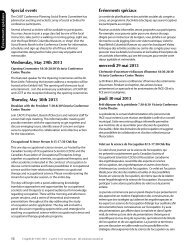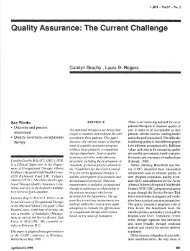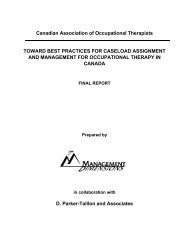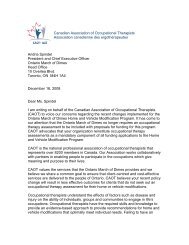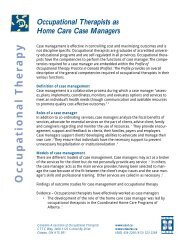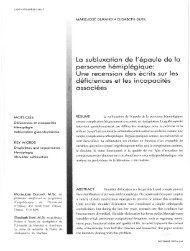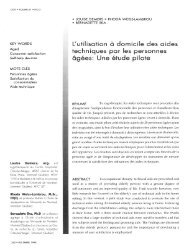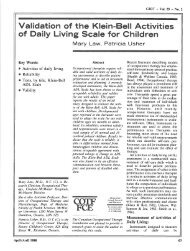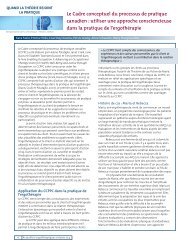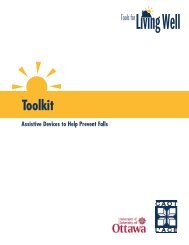Home and community occupational therapy for children and youth: A ...
Home and community occupational therapy for children and youth: A ...
Home and community occupational therapy for children and youth: A ...
Create successful ePaper yourself
Turn your PDF publications into a flip-book with our unique Google optimized e-Paper software.
<strong>Home</strong> <strong>and</strong> <strong>community</strong> <strong>occupational</strong> <strong>therapy</strong> <strong>for</strong> <strong>children</strong> <strong>and</strong> <strong>youth</strong>:<br />
A be<strong>for</strong>e <strong>and</strong> after study<br />
Mary Law ■ Annette Majnemer ■ Mary Ann McColl ■ Jackie Bosch ■ Steven Hanna ■ Seanne Wilkins<br />
Stephen Birch ■ Jessica Tel<strong>for</strong>d ■ Debra Stewart<br />
Key words<br />
■ <strong>Home</strong> <strong>occupational</strong> <strong>therapy</strong> ■ Health care costs ■ Rehabilitation, <strong>community</strong>-based<br />
Abstract<br />
Background. There has been an increased focus on home care service provision in recent years, yet there are few data available<br />
about the provision of home <strong>and</strong> <strong>community</strong> <strong>occupational</strong> <strong>therapy</strong> <strong>for</strong> <strong>children</strong> <strong>and</strong> <strong>youth</strong>.Purpose.To evaluate key elements of<br />
a service provision model <strong>for</strong> home care <strong>occupational</strong> <strong>therapy</strong> in terms of <strong>occupational</strong> per<strong>for</strong>mance outcomes, perception of<br />
care <strong>and</strong> cost. Methods. Eleven centres in Ontario <strong>and</strong> Quebec recruited 167 <strong>children</strong> <strong>and</strong> <strong>youth</strong> up to 18 years of age to a be<strong>for</strong>e<br />
<strong>and</strong> after study of <strong>occupational</strong> <strong>therapy</strong> services in the home <strong>and</strong> <strong>community</strong>. Occupational per<strong>for</strong>mance, quality of life <strong>and</strong> costs<br />
were measured at baseline <strong>and</strong> study end. Perception of care was measured at study completion.Results. A statistically <strong>and</strong> clinically<br />
significant improvement in <strong>occupational</strong> per<strong>for</strong>mance was demonstrated (p
LAW ET AL.<br />
proportionately larger than <strong>for</strong> adults receiving rehabilitation<br />
because of their developmental stage. Occupational <strong>therapy</strong><br />
services may be of particular importance since they promote<br />
long-term change in <strong>occupational</strong> per<strong>for</strong>mance ability <strong>and</strong><br />
potentially prevent or decrease the need <strong>for</strong> health <strong>and</strong> social<br />
services in the future.<br />
There is increasing evidence in the research literature<br />
supporting the effectiveness of <strong>occupational</strong> <strong>therapy</strong> interventions<br />
provided to <strong>children</strong> <strong>and</strong> <strong>youth</strong> with disabilities<br />
through home <strong>and</strong> <strong>community</strong> care programs (McGibbon<br />
Lammi & Law, 2003; Miller et al., 2001). Occupational <strong>therapy</strong><br />
home care services focus on enabling <strong>children</strong> <strong>and</strong> <strong>youth</strong><br />
with health issues <strong>and</strong>/or disabilities to engage in daily occupations<br />
of their choice, including participation in self-care,<br />
work, school, household <strong>and</strong> <strong>community</strong> activities, social<br />
relationships, play <strong>and</strong> leisure. Children with special needs<br />
experience lower rates of participation in ordinary daily<br />
activities (Brown & Gordon, 1987; Pless, Cripps, Davies, &<br />
Wadsworth, 1989). This pattern of restricted occupation<br />
appears to start early, <strong>and</strong> is ingrained by adolescence.<br />
Children with special needs also experience social isolation<br />
(Blum, Resnick, Nelson, & St. Germaine, 1991; Cadman,<br />
Boyle, Szatmari, & Of<strong>for</strong>d, 1987; LaGreca, 1990; Law &<br />
Dunn, 1993). Enabling participation in the typical activities<br />
of childhood is the major focus <strong>for</strong> pediatric <strong>occupational</strong><br />
<strong>therapy</strong>.<br />
Although there is variation in service provision across<br />
regions, current practice in home <strong>and</strong> <strong>community</strong> <strong>occupational</strong><br />
<strong>therapy</strong> typically follows Canadian evidence-based guidelines<br />
<strong>for</strong> an occupation-based, client-centred practice (Canadian<br />
Association of Occupational Therapists [CAOT], 1997).<br />
Although the relationship between service utilization<br />
<strong>and</strong> outcomes from <strong>occupational</strong> <strong>therapy</strong> services is becoming<br />
an increasing focus of research (Alex<strong>and</strong>er, Bugge, &<br />
Hagen, 2001; Finlayson & DalMonte, 2002; Flood et al.,<br />
2005), there is little knowledge about the impact of different<br />
service utilization patterns on <strong>occupational</strong> per<strong>for</strong>mance<br />
outcomes, cost, <strong>and</strong> perceptions of care <strong>for</strong> <strong>children</strong> <strong>and</strong><br />
<strong>youth</strong> in Canada. This study was undertaken to collect data<br />
that would provide in<strong>for</strong>mation about the relative influences<br />
of service delivery models, <strong>and</strong> in particular how the levels<br />
<strong>and</strong> methods of service relate to <strong>occupational</strong> per<strong>for</strong>mance<br />
outcomes, cost <strong>and</strong> perceptions of care. Specific study<br />
hypotheses were:<br />
• A direct service model (in contrast to consultative) is<br />
most costly, but results in better client/family perception<br />
of care <strong>and</strong> better outcomes.<br />
• The frequency, duration <strong>and</strong> intensity of service are<br />
positively related to all three outcomes of cost, perception<br />
<strong>and</strong> <strong>occupational</strong> per<strong>for</strong>mance.<br />
• A <strong>therapy</strong> focus on participation <strong>and</strong> environment<br />
results in positive <strong>occupational</strong> per<strong>for</strong>mance outcomes,<br />
while maintaining the same costs.<br />
• Personal <strong>and</strong> contextual variables, such as age, severity<br />
of disability, <strong>and</strong> levels of support significantly affect<br />
service utilization patterns such as model, amount <strong>and</strong><br />
focus <strong>and</strong> outcomes.<br />
The conceptual model to guide the analysis is drawn in<br />
Figure 1. Such in<strong>for</strong>mation can enhance the ability of decision-makers<br />
at all levels (i.e. clinical managers, program<br />
managers, <strong>and</strong> policy makers) in planning these health<br />
services.<br />
Methods<br />
Study design<br />
The study used a prospective be<strong>for</strong>e <strong>and</strong> after design.<br />
Participants referred to <strong>occupational</strong> <strong>therapy</strong> in either the<br />
home or <strong>community</strong> settings were eligible <strong>for</strong> the study.<br />
Those who along with their family, consented to participate<br />
were evaluated prior to the initiation of <strong>occupational</strong> <strong>therapy</strong><br />
services <strong>and</strong> at the end of the intervention period or 6<br />
months, whichever came first. Occupational per<strong>for</strong>mance,<br />
quality of life <strong>and</strong> costs were measure at baseline <strong>and</strong> study<br />
end. Perception of care was measured at study completion.<br />
This study was not a clinical trial comparing interventions<br />
but rather focused on the relationships between service utilization<br />
variables <strong>and</strong> outcomes/cost.<br />
Recruitment<br />
A total of 175 <strong>children</strong> <strong>and</strong> <strong>youth</strong> were recruited from eight<br />
centres in Ontario <strong>and</strong> three centres in Quebec. The centres<br />
in Ontario were primarily publicly funded while the centres<br />
in Quebec were primarily privately funded. Recruitment<br />
occurred between September 2001 <strong>and</strong> December 2003 <strong>and</strong><br />
the study was coordinated from CanChild Centre <strong>for</strong><br />
Childhood Disability Research, McMaster University.<br />
FIGURE 1<br />
Conceptual model of study hypotheses.<br />
Service utilization<br />
Model of Service<br />
• direct consultation<br />
Amount<br />
• frequency, duration, intensity<br />
Focus<br />
• person, environment<br />
Baseline characteristics<br />
Age<br />
Severity of impairment<br />
Socioeconomic status<br />
Outcomes<br />
Functional Abilities<br />
Perception of care<br />
Cost<br />
290 DÉCEMBRE 2005 ■ REVUE CANADIENNE D’ERGOTHÉRAPIE ■ NUMÉRO 5 ■ VOLUME 72 © CAOT PUBLICATIONS ACE
LAW ET AL.<br />
Inclusion/Exclusion criteria<br />
Children <strong>and</strong> <strong>youth</strong> were eligible <strong>for</strong> referral to the study if they:<br />
• Had a health problem or disability that affected their<br />
ability to per<strong>for</strong>m daily activities;<br />
• Had been admitted to home <strong>and</strong>/or <strong>community</strong> based<br />
<strong>occupational</strong> <strong>therapy</strong> services;<br />
• Were anticipated to receive at least three <strong>occupational</strong><br />
<strong>therapy</strong> visits;<br />
• Were able to speak English or French (depending upon<br />
the centre) sufficiently well to participate in an interview<br />
<strong>and</strong> self-administered questionnaire; <strong>and</strong><br />
• Were between 0 <strong>and</strong> 18 years of age at the time of<br />
recruitment.<br />
Clients were excluded from the study if they:<br />
• Were too ill or rapidly deteriorating to participate in<br />
the therapeutic process; or<br />
• Were discharged prematurely be<strong>for</strong>e three <strong>occupational</strong><br />
<strong>therapy</strong> visits had accrued.<br />
Data collection<br />
Specific variables that were collected during the research are<br />
outlined as follows. At baseline, demographic in<strong>for</strong>mation<br />
such as age, severity of impairment (i.e. number of health<br />
<strong>and</strong>/or development problems), socio-economic status (i.e.<br />
family income), concurrent services <strong>and</strong> equipment used<br />
were obtained. During follow-up, service utilization variables<br />
collected included service model, amount <strong>and</strong> focus. Service<br />
model in<strong>for</strong>mation related to the primary nature of the <strong>occupational</strong><br />
<strong>therapy</strong> service as direct (1:1 <strong>therapy</strong>) or a combination<br />
of direct <strong>and</strong> consultative (provision of education,<br />
in<strong>for</strong>mation <strong>and</strong> home program). Service amount data<br />
included service frequency (number of visits), duration (total<br />
number of weeks receiving <strong>therapy</strong>) <strong>and</strong> intensity (total<br />
hours of <strong>therapy</strong> time). Service focus (person, i.e. individualized<br />
remediation programs <strong>for</strong> writing or environment, i.e.<br />
provision of adaptive equipment or modification to home)<br />
reflected the factors that were addressed during <strong>therapy</strong> in<br />
order to improve <strong>occupational</strong> per<strong>for</strong>mance outcomes. Unit<br />
costs were determined <strong>for</strong> each service agency to allow <strong>for</strong><br />
variations in unit costs between agencies <strong>and</strong> settings.<br />
Therapists used two instruments to measure <strong>occupational</strong><br />
per<strong>for</strong>mance outcomes at baseline <strong>and</strong> study end. The<br />
Canadian Occupational Per<strong>for</strong>mance Measure (COPM)<br />
assessed the client’s perception of per<strong>for</strong>mance in daily activities.<br />
Parents were asked to be proxy respondents if the child<br />
was unable to complete the measures themselves. The COPM<br />
is a well validated, individualized measure designed <strong>for</strong> use<br />
by <strong>occupational</strong> therapists to detect change in a client's<br />
self-perception of per<strong>for</strong>mance in daily occupations (self<br />
care, <strong>community</strong>, work <strong>and</strong> leisure activities) over time (Law<br />
et al., 2005; McColl, Paterson, Davies, Doubt, & Law, 2000;<br />
Pollock & Stewart, 1998). The Pediatric Quality of Life<br />
Inventory (PedsQL) was used as a measure of health-related<br />
quality of life. This measure is a 23-item questionnaire which<br />
generates 4 generic core scales (physical, emotional, social<br />
<strong>and</strong> school functioning) that measure the core dimensions of<br />
health as identified by the World Health Organization<br />
including role, which <strong>for</strong> <strong>children</strong> is considered school functioning,<br />
(Varni, 1998). The reliability <strong>and</strong> validity of the<br />
instrument has been well documented (Varni, Burwinkle,<br />
Seid, & Skarr, 2003; Varni, Seid, & Kurtin, 2001). Both the<br />
COPM <strong>and</strong> the PedsQL were completed at baseline <strong>and</strong> study<br />
end so that change in <strong>occupational</strong> per<strong>for</strong>mance could be<br />
measured.<br />
Perception of care was measured at study end using the<br />
Measure of Processes of Care (MPOC). This 20-item scale<br />
asks parents to rate the care their child received in 5 areas:<br />
enabling <strong>and</strong> partnership, providing general in<strong>for</strong>mation,<br />
providing specific in<strong>for</strong>mation, coordinated <strong>and</strong> comprehensive<br />
care, <strong>and</strong> respectful <strong>and</strong> supportive care (Gan, 1999;<br />
King, Rosenbaum, & King, 1996).<br />
Statistical analysis<br />
All summary statistics including means, st<strong>and</strong>ard deviations<br />
<strong>and</strong> correlations were calculated using SPSS (Statistical<br />
Package <strong>for</strong> the Social Sciences) software version 11.0 <strong>for</strong><br />
Windows (SPSS Inc., 2004). Structural equation modeling<br />
(Kline, 1998) was used to test study hypotheses regarding the<br />
relationships between service model, frequency, <strong>and</strong> focus<br />
with <strong>children</strong>'s age, severity, family income <strong>and</strong> study outcomes.<br />
In a structural equation approach, measurement <strong>and</strong><br />
structural models are developed sequentially to describe the<br />
inter-relationships among variables. The advantage of this<br />
statistical approach is that several factors can be used<br />
together to estimate the concept without measurement error<br />
(Kline, 1998) (similar to the older statistical practice of factor<br />
analysis).The structural model is developed by specifying<br />
TABLE 1<br />
Baseline characteristics.<br />
Characteristics N (%)<br />
Age Range (years)<br />
LAW ET AL.<br />
TABLE 2<br />
Services paid <strong>for</strong> out-of-pocket.<br />
Services N (%)<br />
Speech <strong>and</strong> Language Pathology 15 (9.0 %)<br />
Respite 12 (7.2 %)<br />
Physio<strong>therapy</strong> 11 (6.6 %)<br />
Chiropractor 8 (4.8 %)<br />
Naturopath 8 (4.8 %)<br />
Educator/Developmental Specialist 7 (4.2 %)<br />
Psychologist/Psychiatrist 6 (3.5 %)<br />
Orthotist/Orthopedist 5 (3 %)<br />
Special Needs Worker 4 (2.4 %)<br />
Audiologist 3 (1.8 %)<br />
Social Work 2 (1.2 %)<br />
Nutrition 1 (0.6 %)<br />
the hypothesized causal relationships among the factors<br />
developed in the measurement model (See Figure 1 <strong>for</strong> the<br />
specific relationships tested within this study). These causal<br />
pathways are estimated as regression coefficients in terms of<br />
their direction, size, <strong>and</strong> statistical significance. Summary<br />
measures of overall model fit are also available, <strong>and</strong> can be<br />
used to compare models. Sample size requirements <strong>for</strong> structural<br />
equation models are typically 5-10 participants per<br />
hypothesized pathway. Mplus version 3.11 software was used<br />
to per<strong>for</strong>m the structural equation modeling analysis<br />
(Muthen & Muthen, 1998-2004).<br />
Results<br />
Baseline/Demographics<br />
Of the 175 participants <strong>for</strong> whom baseline data were collected,<br />
study outcome data were available <strong>for</strong> 167 (dropout<br />
rate of 4.6%). Of the 8 participants <strong>for</strong> whom final outcomes<br />
TABLE 3<br />
Equipment paid <strong>for</strong> out-of-pocket.<br />
Equipment N (%)<br />
Mobility<br />
Orthotics 16 (9.6 %)<br />
Splints 9 (5 %)<br />
Wheelchairs 3 (1.8 %)<br />
Walker 3 (1.8 %)<br />
Activities of daily living<br />
Communication device 11 (6.6 %)<br />
Toilet aids (e.g. versa frame, commode) 8 (4.8 %)<br />
Bathing aids (e.g. bath lift, grab bar, shower chair) 4 (2.4 %)<br />
Computer with writing aids 4 (2.4 %)<br />
Feeding pump 3 (1.8 %)<br />
Medical<br />
Ventolin 3 (1.8 %)<br />
Catheters 3 (1.8 %)<br />
Suction equipment <strong>and</strong> IV 1 (0.6 %)<br />
Blood pressure pump 1 (0.6 %)<br />
Asthma machine 1 (0.6 %)<br />
were not collected, 2 were because of hospitalizations, 2<br />
because the client terminated services be<strong>for</strong>e three visits were<br />
completed, <strong>and</strong> 4 were because the attending therapist did not<br />
complete a discharge visit, even after numerous requests from<br />
the project office. There<strong>for</strong>e, all analyses were per<strong>for</strong>med on<br />
the 167 participants <strong>for</strong> whom complete data were collected.<br />
The study participants were primarily male (59%) with a<br />
mean age of 4.8 years (st<strong>and</strong>ard deviation: ± 3.5 years, range; 15<br />
months to 17 years). The youngest participant was 1.5 months<br />
old at the initial visit while the oldest participant was 16 years<br />
old. Almost 70% of the participants had a <strong>for</strong>mal diagnosis<br />
with the most common diagnoses being cerebral palsy, autism<br />
spectrum disorder or developmental delay. Table 1 summarizes<br />
the baseline characteristics of the study population.<br />
Almost all <strong>children</strong> (93%) came from a family with at<br />
least one working parent, <strong>and</strong> just over half (58.1%) of the<br />
families had two parents employed. Approximately 45% of<br />
the families involved in the study had a combined family<br />
annual income of $60,000 CAD or greater. Children received<br />
an average of 3 services (st<strong>and</strong>ard deviation, ± 2.3), of which<br />
0.629 ± 1.08 were not publicly funded, in addition to <strong>occupational</strong><br />
<strong>therapy</strong> <strong>and</strong> any publicly funded services they were<br />
receiving. These types of privately funded services are listed<br />
in Table 2. Of these additional services 2.4% (N=4) were privately<br />
funded <strong>occupational</strong> <strong>therapy</strong>. Payment of out-ofpocket<br />
expenses <strong>for</strong> services was significantly related both to<br />
family income (r = 0.28, p =
LAW ET AL.<br />
TABLE 5<br />
Mean hourly <strong>occupational</strong> <strong>therapy</strong> (OT) costs by subgroups.<br />
Age N (%) Hourly cost Total average OT<br />
median (IQR)<br />
service cost<br />
median (IQR)<br />
< 2 years 40 (24) $32.00 (30.35,32.00) $327.33 (276.31, 581.40)<br />
2 - 5 years 77 (46) $30.35 (29.96, 31.96) $268.09 (203.48, 392.23)<br />
6 - 12 years 44 (26) $31.96 (29.96, 70.00) $322.85 (221.58, 630.00)<br />
13 - 18 years 6 (4) $50.18 (30.35, 70.00) $304.19 (214.73, 580.13)<br />
Number of visits N (%) Hourly cost Total average OT<br />
median (IQR)<br />
service cost<br />
median (IQR)<br />
5 or less visits 21 (12) $32.00 (29.96, 70.00) $208.00 (118.21, 262.67)<br />
6 - 10 visits 80 (48) $30.35 (29.96, 32.00) $272.32 (215.23, 334.00)<br />
11 + visits 66 (40) $31.15 (29.96, 39.00) $510.89 (301.47, 866.75)<br />
IQR = interquartile range<br />
Occupational <strong>therapy</strong> intervention<br />
The study follow-up time was 6 months. The mean number<br />
of <strong>occupational</strong> <strong>therapy</strong> visits per child was 10.8. The average<br />
visit length was approximately one hour. The majority of participants<br />
(87.4%) were already on the therapist's caseload at<br />
study baseline, <strong>and</strong> had been seen by <strong>occupational</strong> <strong>therapy</strong><br />
previously. A similar proportion (75%) were continuing<br />
treatment after the study was completed.<br />
The majority of visits were <strong>community</strong> based at <strong>children</strong>'s<br />
centres as opposed to home based (65% versus 35%)<br />
(Table 4). The focus of service was primarily person, as<br />
opposed to person/environment (58% versus 42%) <strong>and</strong><br />
delivered primarily as direct/consultative as opposed to direct<br />
only (53% versus 47%). The median cost of <strong>occupational</strong><br />
<strong>therapy</strong> intervention was $30.55 CAD per hour with an<br />
overall median cost per participant of about $298.44 (CAD)<br />
over the 6-month period of the study. Table 5 outlines the<br />
cost of <strong>occupational</strong> <strong>therapy</strong> by age <strong>and</strong> number of visits.<br />
TABLE 6<br />
COPM results.<br />
Maximum Per<strong>for</strong>mance Satisfaction<br />
score score score<br />
mean (SD) mean (SD)<br />
Baseline 3.7 (±1.5) 4.2 (±1.5)<br />
10<br />
n= 166 n=166<br />
Study end 6.2 (±1.5)* 6.7 (±1.8)*<br />
10<br />
n =165 n=166<br />
* statistically significant difference in score at p
LAW ET AL.<br />
TABLE 8<br />
PedsQL results by subscale.<br />
Scale Max. Initial visit Study end<br />
score N mean (SD) N mean (SD)<br />
p<br />
Physical functioning 100 162 56.7 (±25.7) 143 61.9 (±25.4)
LAW ET AL.<br />
TABLE 10<br />
Measures of processes of care results by subscale.<br />
Score<br />
Scale Max. score N mean (SD)<br />
Enabling <strong>and</strong> partnership 7 150 5.9 (±1.1)<br />
Providing general in<strong>for</strong>mation 7 136 4.7 (±1.8)<br />
Providing specific in<strong>for</strong>mation 7 150 5.5 (±1.4)<br />
Coordinated <strong>and</strong> supportive care 7 148 6.0 (±1.1)<br />
Respectful <strong>and</strong> supportive care 7 151 6.2 (±0.9)<br />
more severe disabilities tended to pay more out-of-pocket<br />
expenses <strong>and</strong> this was not dependent upon the family<br />
income. The original intent was to examine cost in terms of a<br />
best service provision model, however the structural equation<br />
modeling did not demonstrate any relationships so<br />
further cost analysis was not pursued.<br />
Families’ perceptions of care were promising, <strong>and</strong><br />
indicated that their needs are predominantly being met. The<br />
families participating in this study rated <strong>occupational</strong> <strong>therapy</strong><br />
services more favorably than ratings of overall <strong>children</strong>’s<br />
rehabilitation services across the province (King et al., 1996).<br />
This finding could be attributed to the client-centred focus<br />
emphasized in this study <strong>and</strong> the fact that perception was<br />
being measured <strong>for</strong> only one, not multiple services.<br />
The original hypotheses of significant relationships<br />
between focus, intensity <strong>and</strong> model of service to outcome<br />
were not supported in this study. There are several possible<br />
explanations <strong>for</strong> this finding. First, these results could indicate<br />
that therapists are choosing the appropriate number of<br />
visits <strong>for</strong> each client in order to achieve their goals. The<br />
client-centred approach to <strong>therapy</strong> can streamline the<br />
process of issue identification <strong>and</strong> prioritization (CAOT,<br />
1997). This process may enable therapists to be both efficient<br />
<strong>and</strong> effective in addressing <strong>occupational</strong> per<strong>for</strong>mance<br />
deficits. A second reason <strong>for</strong> the lack of relationship could be<br />
that a large number of <strong>children</strong> were receiving additional<br />
services along with <strong>occupational</strong> <strong>therapy</strong> or their parents<br />
were providing increased support. The download of the<br />
financial responsibility of service provision to the family of<br />
<strong>children</strong> with disabilities is not unique to the Canadian<br />
health care system. Call, Wisner, Blum, Kelly, <strong>and</strong> Nelson<br />
(1997) described a similar trend in the United States, even <strong>for</strong><br />
families who belonged to health maintenance organizations.<br />
Since <strong>children</strong> were receiving additional therapies, perhaps<br />
the duration <strong>and</strong> intensity of these therapies also need to be<br />
included in the model. Un<strong>for</strong>tunately, sufficient in<strong>for</strong>mation<br />
was not collected on the additional therapies to enable that to<br />
occur in this study. A third explanation could be that the<br />
study did not have enough participants to detect the<br />
relationships. The original sample size <strong>for</strong> the study was 242<br />
participants, however even with an extended recruitment<br />
period, this was not possible to attain. The major obstacle to<br />
recruitment was the therapists' time. Therapists noted that<br />
they did not have the time to find participants <strong>and</strong> then to<br />
also explain the study to families, even though therapists were<br />
reimbursed <strong>for</strong> time spent in study related activities. Miller,<br />
McKeever <strong>and</strong> Coyte (2003) also noted staffing shortages as a<br />
common barrier to recruitment in home care studies.<br />
Although it is preferential to believe that the first explanation<br />
FIGURE 2<br />
Structural equation model.<br />
Baseline characteristics<br />
Age Impairment Socio-economic status<br />
-0.18<br />
COPM 1<br />
PedsQL 1<br />
0.52<br />
0.82<br />
COPM 2<br />
PedsQL 2<br />
Outcomes<br />
Service<br />
© CAOT PUBLICATIONS ACE<br />
VOLUME 72 ■ NUMBER 5 ■ CANADIAN JOURNAL OF OCCUPATIONAL THERAPY ■ DECEMBER 2005 295
LAW ET AL.<br />
of the study results is accurate, the other factors that may<br />
affect outcome cannot be ignored.<br />
As <strong>occupational</strong> therapists practicing in Canada, it is<br />
important to consider the implications of these findings. The<br />
results of this study found a significant improvement in <strong>occupational</strong><br />
per<strong>for</strong>mance outcomes after home <strong>and</strong> <strong>community</strong><br />
<strong>occupational</strong> <strong>therapy</strong> services. Yet, we found no significant<br />
relationship between service intensity (number of <strong>occupational</strong><br />
<strong>therapy</strong> visits) <strong>and</strong> outcomes. In fact, <strong>children</strong> <strong>and</strong><br />
<strong>youth</strong> receiving greater than 11 visits experienced the same<br />
amount of change in per<strong>for</strong>mance as those receiving fewer<br />
visits. Therapists should consider measuring changes in<br />
outcome regularly to determine if per<strong>for</strong>mance goals have<br />
been met. The results of this study indicate that more <strong>therapy</strong><br />
does not necessarily result in greater improvements in<br />
<strong>occupational</strong> per<strong>for</strong>mance outcomes.<br />
Conclusion<br />
These results indicate that a client-centred approach to<br />
<strong>occupational</strong> <strong>therapy</strong> is related to a positive change in <strong>occupational</strong><br />
per<strong>for</strong>mance <strong>and</strong> quality of life outcomes, there is<br />
no significant relationship between amount of service <strong>and</strong><br />
outcome, <strong>and</strong> parents of <strong>children</strong> with disabilities feel the<br />
need to supplement publicly funded services. Further<br />
research into the relationships between service provision,<br />
cost <strong>and</strong> outcomes of <strong>occupational</strong> <strong>therapy</strong> <strong>for</strong> <strong>children</strong> <strong>and</strong><br />
<strong>youth</strong> in the home <strong>and</strong> <strong>community</strong> is needed.<br />
Acknowledgements<br />
This research was generously funded with grants from the<br />
Hospital <strong>for</strong> Sick Children Foundation <strong>and</strong> the Max Bell<br />
Foundation.<br />
We would like to sincerely thank the <strong>occupational</strong> therapists<br />
<strong>and</strong> the families who took the time to participate in this<br />
research project from: KidsAbility Centre <strong>for</strong> Child<br />
Development in Waterloo, Ontario; Sudbury Regional<br />
Children's Treatment Centre in Sudbury, Ontario; Therapy<br />
Partners Incorporated in Guelph, Ontario; Montreal<br />
Children's Hospital in Montreal, Quebec; Halton Parent<br />
Infant Programme in Halton, Ontario; Pace <strong>Home</strong> Care<br />
Services in Kitchener, Ontario; L’ergothérapie de la maison à<br />
l’école in Montreal, Quebec; Shirley Sutton Private Clinic in<br />
Collingwood, Ontario; MacKay Center in Montreal, Quebec;<br />
Grey Bruce Health Services in Owen Sound, Ontario; <strong>and</strong><br />
Soldiers’ Memorial Hospital in Orillia, Ontario.<br />
References<br />
Alex<strong>and</strong>er, H., Bugge, C., & Hagen, S. (2001). What is the association<br />
between the different components of stroke rehabilitation <strong>and</strong><br />
health outcomes? Clinical Rehabilitation, 15, 207-215.<br />
Anderson, M., & Parent, K. (1999). Putting a face on home care. The<br />
CARP report on home care in Canada. Toronto, ON: CARP.<br />
Blum, R.W., Resnick, M.D., Nelson, R., & St. Germaine, A. (1991).<br />
Family <strong>and</strong> peer issues among adolescents with spina bifida <strong>and</strong><br />
cerebral palsy. Pediatric, 88, 280-5.<br />
Brown, M., & Gordon, W.A. (1987). Impact of impairment on activity<br />
patterns of <strong>children</strong>. Archives of Physical Medicine <strong>and</strong><br />
Rehabilitation, 68, 828-32.<br />
Cadman, D., Boyle, M., Szatmari, P., & Of<strong>for</strong>d, D.R. (1987). Chronic<br />
illness, disability, <strong>and</strong> mental <strong>and</strong> social well-being: Findings of<br />
the Ontario Child Health Study. Pediatrics, 79, 805-13.<br />
Call K. T., Wisner C. L., Blum R.M., Kelly A., & Nelson A. (1997).<br />
Children with chronic illness <strong>and</strong> disease in managed care<br />
[abstract]. Abstract Book/Association <strong>for</strong> Health Services<br />
Research, 14,143-4.<br />
Canadian Association of Occupational Therapists. (1997). Enabling<br />
occupation: An <strong>occupational</strong> <strong>therapy</strong> perspective. Ottawa, ON:<br />
CAOT Publications ACE.<br />
Finlayson, M., & DalMonte, J. (2002). Predicting the use of <strong>occupational</strong><br />
<strong>therapy</strong> services among people with multiple sclerosis in<br />
Atlantic Canada. Canadian Journal of Occupational Therapy, 69,<br />
239-248.<br />
Flood, C., Mug<strong>for</strong>d, M., Stewart, S., Harvey, I., Pol<strong>and</strong>, F., & Lloyd-<br />
Smith, W. (2005). Occupational <strong>therapy</strong> compared with social<br />
work assessment <strong>for</strong> older people. An economic evaluation<br />
alongside the CAMELOT r<strong>and</strong>omised controlled trial. Age<br />
Ageing, 34, 47-52.<br />
Gan, C. (1999). Measure of processes of care (young adults). Toronto<br />
ON: Bloorview MacMillan Rehabilitation Centre.<br />
Holl<strong>and</strong>er, M.J. (2002). Substudy 7: Overview of home care clients.<br />
Health Transition Fund, Health Canada. Ottawa, ON: Health<br />
Canada.<br />
King, S., Rosenbaum, P., & King, G. (1996). Parents' perceptions of<br />
caregiving: Development <strong>and</strong> validation of a measure of<br />
processes. Developmental Medicine <strong>and</strong> Child Neurology, 38,<br />
757-772.<br />
Kirby, M. (2002). The health of Canadians - The federal role. Final<br />
report - volume six: Recommendations <strong>for</strong> re<strong>for</strong>m. Ottawa, ON:<br />
The St<strong>and</strong>ing Senate Committee on Social Affairs, Science <strong>and</strong><br />
Technology.<br />
Klein, R. (1998) Principles <strong>and</strong> practice of structural equation modeling,<br />
New York, NY: Guil<strong>for</strong>d Publications.<br />
La Greca, A.M. (1990). Social consequences of pediatric conditions:<br />
Fertile area <strong>for</strong> future investigation <strong>and</strong> intervention. Journal of<br />
Pediatric Psychology, 15, 285-307.<br />
Law, M., Baptiste, S., Carswell, A., McColl, M., Polatajko, H., &<br />
Pollock, N. (2005). Canadian Occupational Per<strong>for</strong>mance<br />
Measure (4th ed.). Ottawa, ON: CAOT Publications ACE.<br />
Law M., & Dunn W. (1993) Perspectives on underst<strong>and</strong>ing <strong>and</strong><br />
changing the environments of <strong>children</strong> with disabilities ... including<br />
commentary by Cintas, H. M. with author response. Physical<br />
<strong>and</strong> Occupational Therapy in Pediatrics, 13(3), 1-17, 19-24.<br />
Little, J. A., & Rubin, D. B. (2003). Statistical analysis with missing<br />
data (2nd ed.). Hoboken, NJ: Wiley.<br />
McColl, M. A., Paterson, M., Davies, D., Doubt, L., & Law, M.<br />
(2000). Validity <strong>and</strong> <strong>community</strong> utility of the Canadian<br />
Occupational Per<strong>for</strong>mance Measure. Canadian Journal of<br />
Occupational Therapy, 67, 22-30.<br />
McGibbon Lammi, B.M., & Law, M. (2003). The effects of familycentred<br />
functional <strong>therapy</strong> on <strong>occupational</strong> per<strong>for</strong>mance of<br />
<strong>children</strong> with cerebral palsy. Canadian Journal of Occupational<br />
Therapy, 70, 285-97.<br />
296 DÉCEMBRE 2005 ■ REVUE CANADIENNE D’ERGOTHÉRAPIE ■ NUMÉRO 5 ■ VOLUME 72 © CAOT PUBLICATIONS ACE
LAW ET AL.<br />
Miller K.L., & McKeever P., & Coyte, P. C. (2003). Recruitment issues<br />
in healthcare research: The situation in home care. Health <strong>and</strong><br />
Social Care in the Community, 11, 111-123.<br />
Miller, L.T., Polatajko, H.J., Missiuna, C., M<strong>and</strong>ich, A.D., & Macnab,<br />
J.J. (2001). A pilot trial of a cognitive treatment <strong>for</strong> <strong>children</strong><br />
with developmental coordination disorder. Human Movement<br />
Science, 20, 183-210.<br />
Muthen L. K., & Muthen, B.O. (1998-2004). Mplus User's Guide (3rd<br />
ed.). Los Angeles, CA: Muthen <strong>and</strong> Muthen.<br />
National Conference on <strong>Home</strong> Care. (1998). Conference proceedings.<br />
Ottawa, ON: Health Canada.<br />
National Forum on Health. (1997). Canada health action: Building<br />
on the legacy. Ottawa, ON: Minister of Public Works <strong>and</strong><br />
Government Services.<br />
Ontario Ministry of Health <strong>and</strong> Long-Term Care. (2005).<br />
Trans<strong>for</strong>ming health care. Retrieved August 8, 2005, from<br />
Ontario Ministry of Health <strong>and</strong> Long-Term Care Web site:<br />
http://www.health.gov.on.ca/trans<strong>for</strong>mation/.<br />
Pless, J. B., Cripps, H. A., Davies, J. M., & Wadsworth, M. E. (1989).<br />
Chronic physical illness in childhood: Psychological <strong>and</strong> social<br />
effects in adolescence <strong>and</strong> adult life. Developmental Medicine<br />
<strong>and</strong> Child Neurology, 31, 746-55.<br />
Pollock, N., & Stewart, D. (1998). Occupational per<strong>for</strong>mance needs of<br />
school-aged <strong>children</strong> with physical disabilities in the <strong>community</strong>.<br />
Physical <strong>and</strong> Occupational Therapy in Paediatrics, 18, 55-68.<br />
Romanow, R. (2002). Building on values: The future of health care in<br />
Canada. Final report. Ottawa, ON: Commission on the Future<br />
of Health Care.<br />
SPSS, Inc. (2004). Statistical package <strong>for</strong> the social sciences<br />
[Software version 11.0 <strong>for</strong> Windows]. Retrieved from Web site<br />
http:// www.spss.com/.<br />
Varni, J.W. (1998). PedsQL Pediatric Quality of Life Inventory.<br />
Retrieved from Web site http://www.pedsql.org/about_pedsql.<br />
html.<br />
Varni J.W., Burwinkle T. M., Seid M., & Skarr D. (2003). The PED-<br />
SQL 4.0 as a pediatric population health measure: Feasibility,<br />
reliability, <strong>and</strong> validity. Ambulatory Pediatrics, 3, 329-41.<br />
Varni J.W., Seid M., & Kurtin P.S. (2001). The PedsQL 4.0: Reliability<br />
<strong>and</strong> validity of the Pediatric Quality of Life Inventory Version<br />
4.0 Generic Core Scales in healthy <strong>and</strong> patient populations.<br />
Medical Care, 39, 800-812.<br />
Authors<br />
Mary Law, PhD, OT Reg (Ont.), is Associate Dean <strong>and</strong> Professor,<br />
School of Rehabilitation Science, McMaster University, Institute<br />
<strong>for</strong> Applied Health Sciences, 1400 Main St. W. Hamilton, ON<br />
L8S 1C7 E-mail: lawm@mcmaster.ca.<br />
Annette Majnemer, PhD, OT, is Professor, School of Physical <strong>and</strong><br />
Occupational Therapy, McGill University, Montreal, PQ.<br />
Mary Ann McColl, PhD, OT Reg (Ont.), is Professor, School of<br />
Rehabilitation Therapy, Queen's University, Kingston, ON.<br />
Jackie Bosch, MSc, OT Reg (Ont.), is Assistant Professor, School of<br />
Rehabilitation Science, McMaster University, Hamilton, ON.<br />
Steven Hanna, PhD, is Assistant Professor, Department of Clinical<br />
Epidemiology <strong>and</strong> Biostatistics <strong>and</strong> School of Rehabilitation<br />
Science, McMaster University, Hamilton, ON.<br />
Seanne Wilkins, PhD, OT Reg (Ont.), is Associate Professor, School<br />
of Rehabilitation Science, McMaster University, Hamilton, ON.<br />
Stephen Birch, PhD, is Professor, Department of Clinical Epidemiology<br />
<strong>and</strong> Biostatistics, McMaster University, Hamilton, ON.<br />
Jessica Tel<strong>for</strong>d, BA, is Research Assistant, School of Rehabilitation<br />
Science, McMaster University, Hamilton, ON.<br />
Debra Stewart, MSc, OT Reg (Ont.), is Assistant Dean (OT), School<br />
of Rehabilitation Science, McMaster University, Hamilton, ON.<br />
Copyright of articles published in the Canadian Journal of Occupational Therapy (CJOT) is held by the Canadian Association of Occupational Therapists. Permission must be obtained in writing<br />
from CAOT to photocopy, reprint, reproduce (in print or electronic <strong>for</strong>mat) any material published in CJOT.There is a per page, per table or figure charge <strong>for</strong> commercial use.When referencing this<br />
article, please use APA style, citing both the date retrieved from our web site <strong>and</strong> the URL. For more in<strong>for</strong>mation, please contact: copyright@caot.ca.<br />
© CAOT PUBLICATIONS ACE<br />
VOLUME 72 ■ NUMBER 5 ■ CANADIAN JOURNAL OF OCCUPATIONAL THERAPY ■ DECEMBER 2005 297



